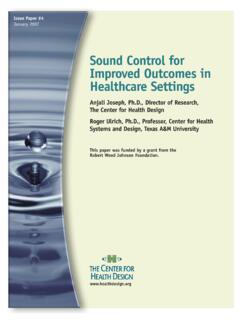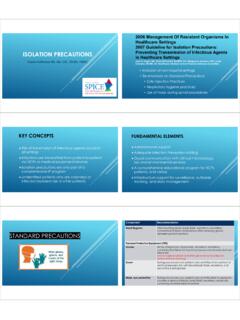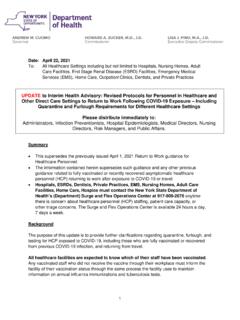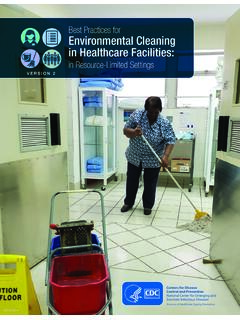Transcription of This slide set “Hand Hygiene in Healthcare Settings-
1 1 This slide set Hand Hygiene in Healthcare Settings- Core and accompanying speaker notes provide an overview of the Guideline for Hand Hygiene in Health-care Settings published in 2002. A second slide set Hand Hygiene in Healthcare Settings- Supplemental which can be obtained at additional slides that may be used in conjunction with the core slide target audience for this slide set is Healthcare workers in acute care Hygiene in Healthcare Settings: An OverviewGuideline for Hand Hygiene in Health-care Settings. MMWR 2002; vol. 51, no. RR-16. Background Definitions Indications Selection of Agents Techniques Surgical Other3 Most common mode of transmission of pathogens is via hands ! Infections acquired in Healthcare Spread of antimicrobial resistanceSo Why All the Fuss About Hand Hygiene ? Clean hands are the single most important factor in preventing the spread of pathogens and antibiotic resistance in Healthcare settings.
2 Hand Hygiene reduces the incidence of Healthcare associated infections. CDC estimates that each year nearly 2 million patients in the United States get an infection in hospitals, and about 90,000 ofthese patients die as a result of their infection. More widespread use of hand Hygiene products that improve adherence to recommended hand Hygiene practices will promote patient safety and prevent infections. 4 Evidence of Relationship Between Hand Hygiene and Healthcare -Associated Infections Substantial evidence that hand Hygiene reduces the incidence of infections Historical study: Semmelweis More recent studies: rates lower when antiseptic handwashing was performedGuideline for Hand Hygiene in Health-care Settings. MMWR 2002; vol. 51, no. RR-16. There is substantial evidence that hand Hygiene reduces the incidence of infections. Semmelweis demonstrated that the mortality rate among mothers who delivered in the First Obstetrics Clinic at the General Hospital of Vienna was significantly lower when hospital staff cleaned their hands with an antiseptic agent thanwhen they washed their hands with plain soap and water.
3 In more recent studies Healthcare -associated infection rates were lower when antiseptic handwashing was performed by personnel and went down when adherence to recommended hand Hygiene practices improved. 5 Hand Hygiene Adherence in Hospitals1. Gould D, J Hosp Infect1994;28:15-30. 2. Larson E, J Hosp Infect1995;30:88-106. 3. Slaughter S, Ann Intern Med1996;3:360-365. 4. Watanakunakorn C, Infect Control Hosp Epidemiol1998;19:858-860. 5. Pittet D,Lancet 2000:356; of Study Adherence Rate Hospital Area1994 (1)29%General and ICU1995 (2)41%General1996 (3)41%ICU1998 (4)30%General2000(5)48%General In general, adherence of Healthcare workers to recommended hand Hygiene procedures has been poor. Studies shown here are representative of the overall adherence rates which averaged about 40%. Adherence rates do vary by Factors for Poor Adherence with Hand Hygiene Handwashing agents cause irritation and dryness Sinks are inconveniently located/lack of sinks Lack of soap and paper towels Too busy/insufficient time Understaffing/overcrowding Patient needs take priority Low risk of acquiring infection from patientsAdapted from Pittet D, Infect Control Hosp Epidemiol2000;21:381-386.
4 Healthcare workers have reported several factors that may negatively impact their adherence with recommended practices including; handwashing agents cause irritation and dryness, sinks are inconveniently located, lack of soap and paper towels, not enough time, understaffing or overcrowding, and patient needs taking priority. Lack of knowledge of guidelines/protocols, forgetfulness, and disagreement with the recommendations were also self reported factors for poor adherence with hand Hygiene . Perceived barriers to hand Hygiene are linked to the institution and HCWs colleagues. Therefore, both institutional and small-group dynamics need to be considered when implementing a system change to secure and improve HCWs hand Hygiene practice. 7 Definitions Hand Hygiene Performing handwashing, antiseptic handwash, alcohol-based handrub, surgical hand Hygiene /antisepsis Handwashing Washing hands with plain soap and water Antiseptic handwash Washing hands with water and soap or other detergents containing an antiseptic agent Alcohol-based handrub Rubbing hands with an alcohol-containing preparation Surgical hand Hygiene /antisepsis Handwashing or using an alcohol-based handrub before operations by surgical personnelGuideline for Hand Hygiene in Health-care Settings.
5 MMWR 2002; vol. 51, no. RR-16. Hand Hygiene is a general term that applies to either handwashing, antiseptic handwash, alcohol-based handrub, or surgical hand Hygiene /antisepsis. Handwashing refers to washing hands with plain soap and water. Handwashing with soap and water remains a sensible strategy for hand Hygiene in non- Healthcare settings and is recommended by CDC and other experts. Antiseptic handwash refers to washing hands with water and soap or other detergents containing an antiseptic agent. Alcohol-based handrub refers to the alcohol-containing preparation applied to the hands to reduce the number of viable microorganisms. Surgical hand Hygiene /antisepsis refers to an antiseptic handwash or antiseptic handrub performed preoperatively by surgical personnel to eliminate transient and reduce resident hand flora. Antiseptic detergent preparations often have persistent antimicrobial for Hand Hygiene When hands are visibly dirty, contaminated, or soiled, wash with non-antimicrobial or antimicrobial soap and water.
6 If hands are not visibly soiled, use an alcohol-based handrub for routinely decontaminating for Hand Hygiene in Health-care Settings. MMWR 2002; vol. 51, no. RR-16. Healthcare workers should wash hands with soap and water when hands are visibly dirty, contaminated or soiled and use an alcohol-based handrub when hands are not visibly soiled to reduce bacterial Indications for Hand Hygiene Before: Patient contact Donning gloves when inserting a CVC Inserting urinary catheters, peripheral vascular catheters, or other invasive devices that don t require surgery After: Contact with a patient s skin Contact with body fluids or excretions, non-intact skin, wound dressings Removing glovesGuideline for Hand Hygiene in Health-care Settings. MMWR 2002; vol. 51, no. RR-16. Hand Hygiene is indicated before: patient contact, donning gloves when inserting a central venous catheter (CVC), and inserting urinary catheters, peripheral vascular catheters, or other invasive devices that don t require surgery.
7 Hand Hygiene is also indicated after contact with a patient s intact skin, contact with body fluids or excretions, non-intact skin, or wound dressings, and after removing gloves. Gloves should be used when a HCW has contact with blood or other body fluids in accordance with universal of Hand Hygiene Agents: Factors to Consider Efficacy of antiseptic agent Acceptance of product by Healthcare personnel Characteristics of product Skin irritation and dryness Accessibility of product Dispenser systemsGuideline for Hand Hygiene in Health-care Settings. MMWR 2002; vol. 51, no. RR-16. When evaluating hand Hygiene products for potential use in Healthcare facilities, administrators or product selection committees should consider the relative efficacy of antiseptic agents against various pathogens and the acceptability of hand Hygiene products by personnel. Product acceptance can be affected by characteristics of the product such as its smell, consistency, color and the effect of skin irritation and dryness on hands .
8 Easy access to hand Hygiene supplies is essential for acceptance and use of products. Dispenser systems should function adequately and deliver an appropriate volume of product. Soap should not be added to a partially empty soap dispenser because of potential bacterial contamination of the of Hand Hygiene Preparations in Killing BacteriaGoodBetterBestPlain SoapAntimicrobial soapAlcohol-based handrub Plain soap is good at reducing bacterial counts but antimicrobial soap is better, and alcohol-based handrubs are the best. 12 Ability of Hand Hygiene Agents to Reduce Bacteria on HandsAdapted from: Hosp Epidemiol Infect Control, 2ndEdition, 1999. ReductionAlcohol-based handrub(70% Isopropanol)Antimicrobial soap(4% Chlorhexidine)Plain soapTime After DisinfectionBaseline This graph shows that alcohol-based handrub is better than handwashing at killing bacteria. Shown across the top of this graph is the amount of time after disinfection with the hand Hygiene agent.
9 The left axis shows the percent reduction in bacterial counts. The three lines represent alcohol-based handrub, antimicrobial soap, and plain weeksAlcohol rubSoap and water15171921232527 Baseline2 weeksAlcohol rubSoap and waterEpidermal water contentSelf-reported skin scoreDryHealthyDryHealthyEffect of Alcohol-Based Handrubs on Skin Condition~ Alcohol-based handrub is less damaging to the skin ~Boyce J, Infect Control Hosp Epidemiol2000;21(7):438-441. Alcohol-based handrubs are less damaging to the skin than soap and water. In the graph on the left the blue bar shows self-reported skin health scores for persons using soap and water, and persons using alcohol-based handrubs are depicted by the orange bar. Self-reported studies indicate participants using soap and water reported a significant increase in dryness, cracking, and irritation after 2 weeks, whereas those that used the alcohol-based handrub reported improvement in skin dryness.
10 Epidermal water content shows the same results as the self reported scores, after 2 weeks of use, the skin water content decreased for those that used soap and water (resulting in dryerskin) as compared with those who used an alcohol-based handrub. 14 Time Spent Cleansing hands :one nurse per 8 hour shift Hand washing with soap and water: 56 minutes Based on seven (60 second) handwashing episodes per hour Alcohol-based handrub: 18 minutes Based on seven (20 second) handrub episodes per hourVoss A and Widmer AF, Infect Control Hosp Epidemiol1997:18;205-208.~ Alcohol-based handrubs reduce time needed for hand disinfection ~ The time required for nurses to leave a patient s bedside, go to a sink, and wash and dry their hands before attending the next patient is a deterrent to frequent handwashing or hand antisepsis. More rapid access to hand Hygiene materials could help improve adherence. Alcohol-based handrubs may be a better option than traditional handwashing with plain soap and water or antiseptic handwash because they require less time, act faster, and irritate hands less often.















